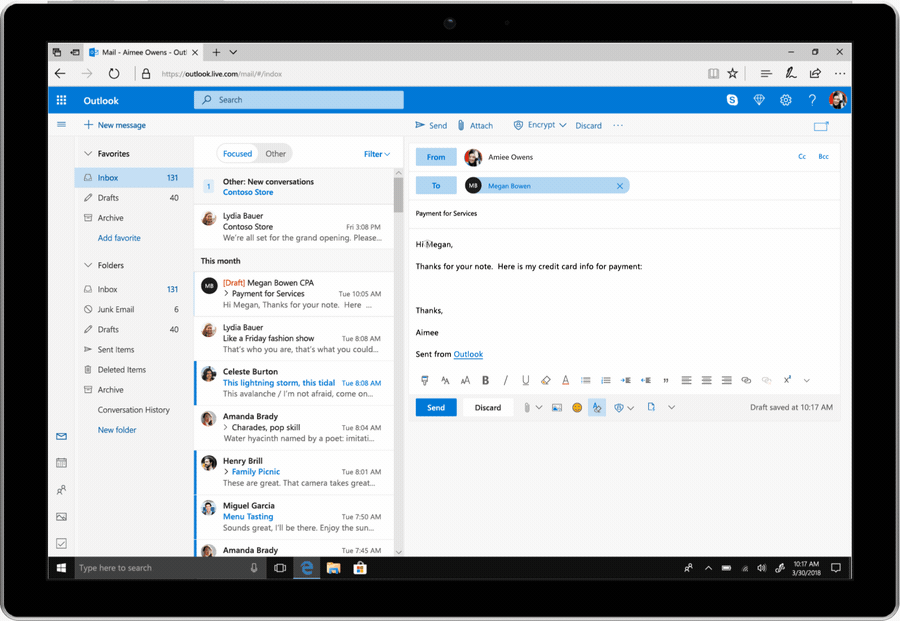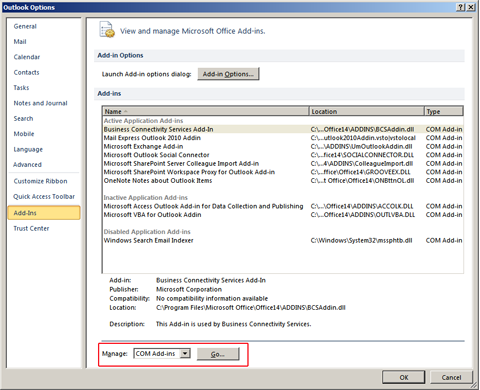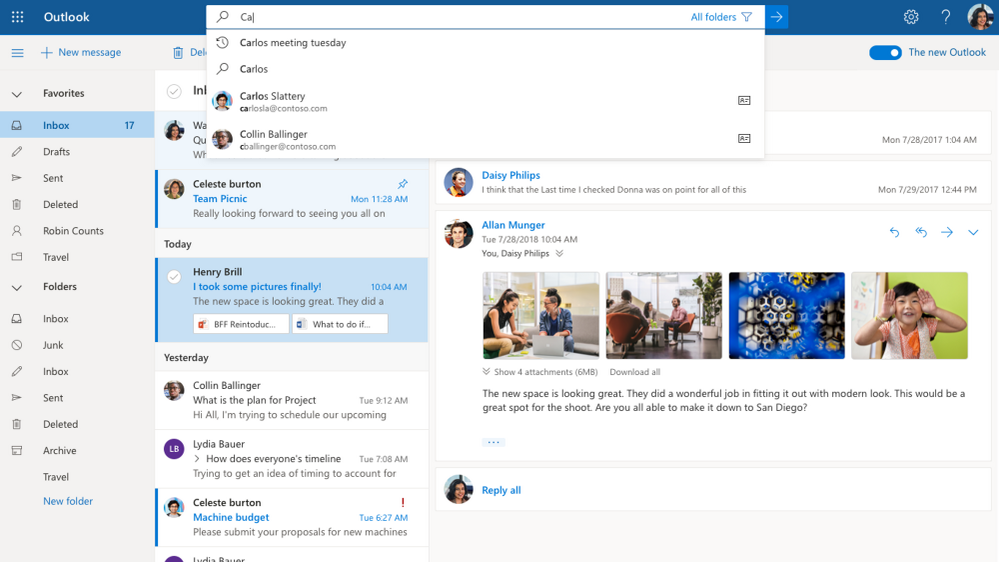Outlook 366
- There are many different types of email accounts you can add to Outlook, including Microsoft 365, Gmail, Yahoo, iCloud, and Exchange accounts. Some third-party email providers, like Gmail, Yahoo, and iCloud, require you to change some settings on their websites before you can add these accounts to Outlook.
- The Microsoft Defender for Office 365 evaluation experience is designed to eliminate the complexities of device and environment configuration so that you can focus on evaluating the capabilities of Microsoft Defender for Office 365. With evaluation mode, all messages sent to Exchange Online mailboxes can be evaluated without pointing MX records.
Topics Map > Migration > Support Staff
Topics Map > Features and Functionality > Client Capabilities > Desktop
This document will guide you through the steps needed to reconnect your local .pst file to your UW-Madison Office 365 Outlook profile.
Outlook.com is a free personal email service from Microsoft that doesn't scan your email for the purpose of serving you ads. Automatically file emails and share photos easily.
Note: For details on .pst/.ost files, review Office 365 (Outlook for Windows/MacOS) - Data files documentation.
Important: By February 28, 2017, Office 2013 version Office 365 ProPlus is no longer available for installation with an Office 365 subscription. Microsoft will no longer push any updates to Office 2013 suite of applications - complete details.
How to identify the name and location of your personal folders file
Microsoft Outlook for Windows

- Start Outlook.
- Click the File tab in the Ribbon, and then click the Info tab on the menu.
- Click the Account Settings tab.
- Click Account Settings again.
- Click Data Files.
Checking the default locations in addition to verifying the existing location is always recommended as there might be some disconnected pst-files which you might have forgotten about but still like to keep anyway. The default locations to check are:
C:Users%username%AppDataLocalMicrosoftOutlookC:Users%username%DocumentsOutlook Files
You may have more than one .pst file you are using. Note the path and file name of each of these files. The name of any .pst file (other than the default - Outlook.pst) will be the same name within your folder structure.
- Click Close, click OK, and then click Exit and Log Off on the File menu to quit Outlook.
How to backup/copy your personal folders file (.pst)
Caution - the Office 365 support team does not recommend storing data locally for the following reasons:

- Security - if someone gets access to your computer, they can easily extract the data from the local data file.
- Loss of data - if the data is not backed up, it cannot be recovered.
- Deleted data - if deleted, Microsoft's recovery tool cannot be used to restore the data.
If you found a local pst file, use the instructions below to backup/copy. If you do not have one and want to create one, follow these instructions: create an Outlook data file. After you have created a local pst folder, you will need to manually move/copy items into it. If you use the move command, it will remove the item from within your Office 365 account and place it within your local folder. This means it will no longer be visible in Outlook on the web and can only be accessed from the computer where you have this local file configured.
- On the Start menu, point to Programs, and then click Windows Explorer.
- Browse through the files to the location of your .pst file (from above).
- Copy your .pst file to the location that you want.
How to point Outlook to your new personal folders file

Important: If you have reconfigured Outlook with a new proflle, use the steps below to connect your pst file to this profile.
Microsoft Outlook for Windows
- Click the File tab.
- Click Open and Export
- Click Open Outlook Data File.
- Search and find the .pst file you want to connect, and then click OK.
- On the File menu, click Exit.
- Restart Outlook.
See Also:
-->As of October 13, 2020, only these versions of Office are supported for connecting to Office 365 (and Microsoft 365) services:
- Microsoft 365 Apps for enterprise (previously named Office 365 ProPlus)
- Microsoft 365 Apps for business (previously named Office 365 Business)
- Office 2019, such as Office Professional Plus 2019
- Office 2016, such as Office Standard 2016
Examples of Office 365 services include Exchange Online, SharePoint Online, and OneDrive for Business.
For Microsoft 365 Apps, you must be using a supported version. For a list of which versions are currently supported, see Update history for Microsoft 365 Apps.
Important
We won’t take any active measures to block other versions of the Office client, such as Office 2013, from connecting to Office 365 services, but these older clients may encounter performance or reliability issues over time.
Impact of using older Office clients to connect to Office 365 services
After October 13, 2020, ongoing investments to our cloud services will not take into account older Office clients. Over time, these Office clients may encounter performance or reliability issues. Organizations that use these older clients will almost certainly face an increased security risk and may find themselves out of compliance depending upon specific regional or industry requirements.
Therefore, administrators should update older Office clients to versions of Office supported for connecting to Office 365 services.
Upgrade resources available to administrators
We recommend that you upgrade older Office clients to a subscription version of the Office client, such as Microsoft 365 Apps for enterprise. The most up-to-date subscription versions of the Office client are always supported connecting to Office 365 services.
We provide various services to help you upgrade to subscription versions of the Office client. The following list provides some examples of resources that are available:
Outlook 365 Email
- Microsoft FastTrack, for migration and deployment assistance from Microsoft experts.
- App Assure, for assistance from Microsoft with application compatibility issues.
- Deployment guide for Microsoft 365 Apps, for technical documentation.
- Product lifecycle dashboard and upgrade readiness dashboard, for users of Microsoft Endpoint Configuration Manager (current branch).
- Readiness Toolkit for Office add-ins and VBA, to help identify potential issues with add-ins and VBA macros used in your organization.
Upcoming changes related to connectivity to Office 365 services
Retirement of TLS 1.0 and 1.1
After October 15, 2020, you must be using at least TLS 1.2 to connect to Office 365 services. For more information, see TLS 1.0 and 1.1 deprecation for Office 365 and Preparing for TLS 1.2 in Office 365 and Office 365 GCC.
Basic authentication with Exchange Online
There are some changes planned related to the use of Basic Authentication with Exchange Online. For more information, see Basic Authentication and Exchange Online – February 2021 Update.
Retirement of Skype for Business Online
Skype for Business Online will be retired on July 31, 2021. For more information, see Skype for Business Online retirement.
Minimum version requirements for Outlook for Windows
Note
The information in this section was communicated in the following Message center post in the Microsoft 365 admin center.
- Message ID: MC229143
- Message title: Update to Microsoft 365 and Outlook for Windows connectivity
- Publish date: December 9, 2020.
Starting on November 1, 2021, the following versions are the minimum versions of Outlook for Windows you need to be using to be able to connect to Microsoft 365 services, such as Exchange Online.
- Version 1706 of Microsoft 365 Apps
- Version 16.0.4600.1000 of Office 2016 (with the November 2017 Update, KB 4051890)
- Version 15.0.4971.1000 of Office 2013 (Service Pack 1 with the October 2017 Update, KB 4043461)
All versions of Outlook 2019 should be able to connect to Microsoft 365 services, but only the most current version is supported.
Even though newer versions of Outlook 2013 might be able to connect to Microsoft 365 services, it's not supported and you may encounter performance or reliability issues.
Versions of Outlook that are newer than those listed, but aren't the most current (supported) versions, may experience connectivity issues. To find what is the most current (supported) version, see the following articles:

Additional information about connectivity to Office 365 services
Outlook 365 Sign In
- Versions of Office 2019 and Office 2016 will be supported for connecting to Office 365 (and Microsoft 365) services until October 2023.
- Connecting to Office 365 services using Office 2016 for Mac isn’t supported. That’s because Office 2016 for Mac reached its end of support on October 13, 2020.
- This information about connecting to Office 365 services also applies to Project and Visio.
- This information about connecting to Office 365 services does not apply to InfoPath 2013 or SharePoint Designer 2013.
- For end of support dates for different versions of Office on various versions of Windows, see the Office configuration support matrix.
- To discuss or learn more about end of support for Office versions, visit Microsoft Office End of Support on the Microsoft Tech Community.
